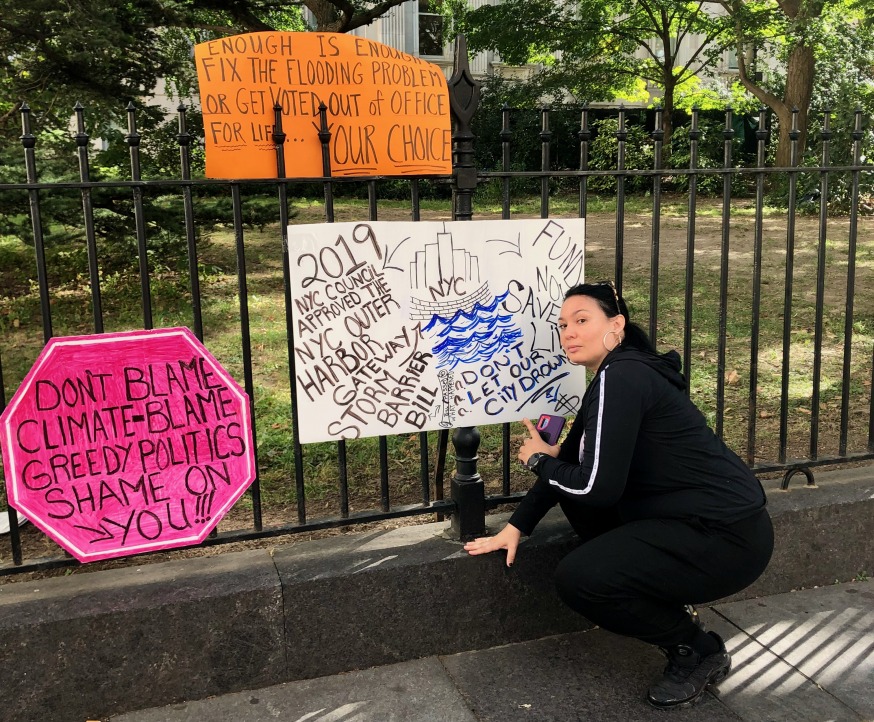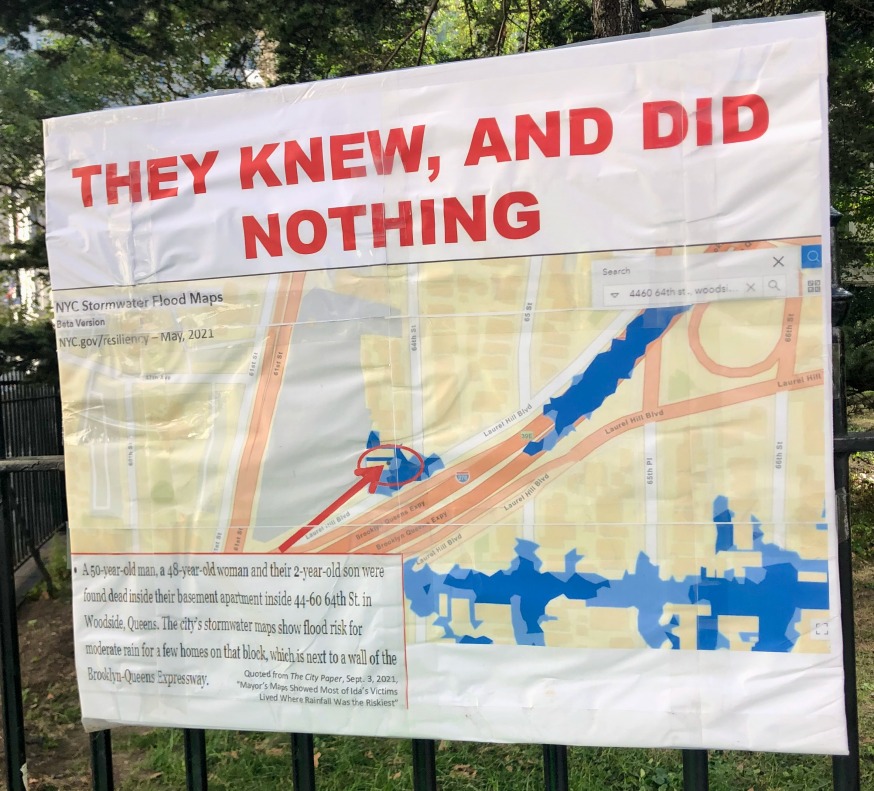
Woodside residents held a small rally outside City Hall Park on Oct. 21 claiming that the city’s failure to fix the sewerage system and other infrastructure played a significant role in the flood. Danette Rivera, pictured, nearly drowned during Hurricane Ida on Sept. 1 (Photo: Sarah Kerson)
Jan. 19, 2022 By Sarah Kerson
Nearly four months after the remnants of Hurricane Ida killed 13 New Yorkers, residents in the hardest-hit areas like Woodside are still struggling with government agencies for financial assistance to repair flood damage.
Many of the victims allege that the damage to their homes is the result of the city’s failure to fix the drainage and sewerage system. They cited decades-long calls for updates to the sewer system.
Linda Carlson, who has lived in her Woodside home since 1994, took on four feet of water when Ida struck on Sept. 1, with three inches of rain falling in just an hour. A contractor quoted her $34,000 in damages. “I was one of the lucky ones,” she said.
Carlson was approved for $11,773.68 in assistance from the Federal Emergency Management Agency, more than what many of her neighbors were approved for, she said.
She was granted an additional $1,419.86 when she appealed the offer—and said others affected by Ida should also contest what’s offered. “Everybody should. This was caused by the city,” she said. “We’ve been fighting for decades to have the infrastructure upgraded.”
Danette Rivera nearly drowned in her Woodside home where she’s lived for 14 years. Her son, who is legally blind, had to pull her out of the basement through a small window as it filled with seven and a half feet of water, she said.
“I’m grateful that I’m a survivor. Not everyone has that story to tell,” she said. “But I’m angry, I’m upset and I’m pissed off. This shouldn’t have happened to me, and it shouldn’t have happened to anybody else. People shouldn’t have died.”
Rivera, who estimates that the cost to repair the damage to her home is about $64,000, also applied for assistance from FEMA, but would not say how much she was offered.
The amount she was approved for fell well short of the cost of the damage, she said.
Like Carlson, she appealed her offer, but received a letter asking for documentation she said had already been sent to the agency. “The appeal process seems like it’s a gimmick,” Rivera said. “Basically, it’s like a runaround.”
FEMA spokesman Scott Sanders told the Queens Post late last year that there could be a variety of reasons why someone might receive less funding than they had hoped. “If you gave me a thousand different applicants, there’s a thousand different stories in there,” he said.
Federal disaster funds, he said, are “not a substitute for insurance. It can supplement insurance, but it can’t duplicate assistance people may get from other sources.”
The deadline to apply for funding from FEMA for New York City residents was Jan. 4, but the agency is providing a 60-day grace period for late applications. Those applications require a letter explaining “extenuating circumstances that prevented them from applying within the application period,” according to FEMA’s website.
Sanders said those who do decide to appeal their FEMA claim have 60 days from when they receive their determination letter to do so.
In total, FEMA has administered $196 million in individual assistance in New York State to over 39,000 approved applicants, according to the agency’s website. That averages out to less than $5,000 per applicant.
FEMA has also partnered with the Small Business Administration to provide low-interest, long-term loans for larger rebuilding projects.
Both Rivera and Carlson remain frustrated with the agency but maintain that their central qualm is with the city’s aging sewer system.
“FEMA is a Band-Aid to the problem,” said Rivera. “We need to upgrade our sewer system, and that is a solution to the problem.”
Carlson agrees. “What I want is accountability for my neighborhood,” she said.

Woodside residents held a small rally outside City Hall Park on Oct. 21 claiming that the city’s failure to fix the sewerage system and other infrastructure played a significant role in the flood. A sign displayed during the rally shows a city map of a floodplain as well as the Woodside location where a 2-year-old boy and his parents died during Hurricane Ida (Photo: Sarah Kerson)






